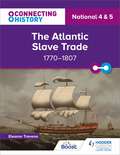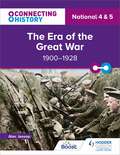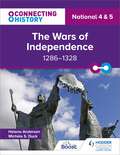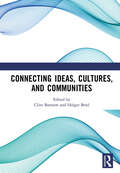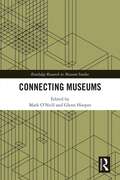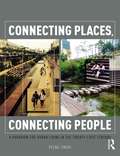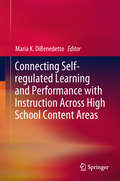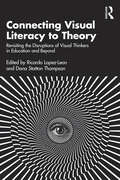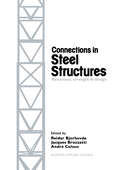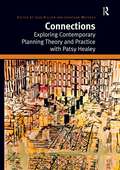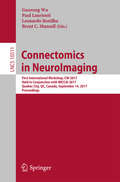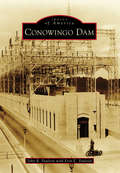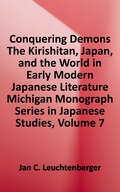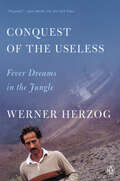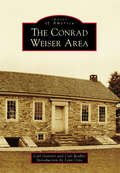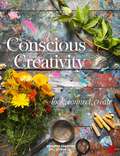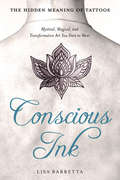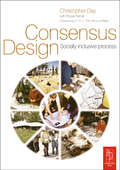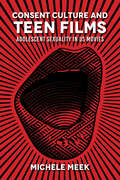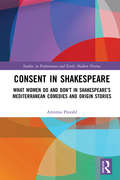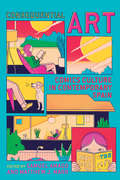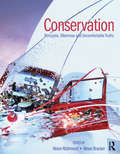- Table View
- List View
Connecting History: National 4 & 5 The Atlantic Slave Trade, 1770–1807
by Eleanor TrevenaExam board: SQALevel: National 4 & 5Subject: HistoryFirst teaching: September 2017First assessment: Summer 2018Fresh stories, fresh scholarship and a fresh structure. Connecting History informs and empowers tomorrow's citizens, today.Bringing together lesser-told narratives, academic excellence, accessibility and a sharp focus on assessment success, this series provides a rich, relevant and representative History curriculum.> Connect the past to the present. Overarching themes of social justice, equality, change and power help students to understand the importance of events and issues, then and now.> Go far beyond other resources. With respect and aspiration for the transformative power of History, this series incorporates the latest research, challenges old interpretations and embeds diverse experiences throughout.> Follow a clear and consistent structure. The key issues in the N5 specification form the chapters in each book, and the content descriptors are subheadings within the chapters. Finding the information that you need has never been easier.> Meet the demands of the assessments. Connecting History develops the knowledge and skills for success, with appropriate breadth, depth and pace. The narrative and sources take centre stage and the authors model the process of answering questions effectively through that narrative, ensuring that students know all the key points that they need to. End-of-chapter activities consolidate and extend learning.> Benefit from pedagogic and academic expertise. The authors are highly experienced teachers and examiners who know how to spark critical curiosity in students. Each book has been rigorously reviewed by an academic from the University of Glasgow, so you can rest assured that the content is accurate and up to date.
Connecting History: National 4 & 5 The Era of the Great War, 1900–1928
by Alec JessopExam board: SQALevel: National 4 & 5Subject: HistoryFirst teaching: September 2017First assessment: Summer 2018Fresh stories, fresh scholarship and a fresh structure. Connecting History informs and empowers tomorrow's citizens, today.Bringing together lesser-told narratives, academic excellence, accessibility and a sharp focus on assessment success, this series provides a rich, relevant and representative History curriculum.> Connect the past to the present. Overarching themes of social justice, equality, change and power help students to understand the importance of events and issues, then and now.> Go far beyond other resources. With respect and aspiration for the transformative power of History, this series incorporates the latest research, challenges old interpretations and embeds diverse experiences throughout.> Follow a clear and consistent structure. The key issues in the N5 specification form the chapters in each book, and the content descriptors are subheadings within the chapters. Finding the information that you need has never been easier.> Meet the demands of the assessments. Connecting History develops the knowledge and skills for success, with appropriate breadth, depth and pace. The narrative and sources take centre stage and the authors model the process of answering questions effectively through that narrative, ensuring that students know all the key points that they need to. Activities throughout each chapter consolidate and extend learning.> Benefit from pedagogic and academic expertise. The authors are highly experienced teachers and examiners who know how to spark critical curiosity in students. Each book has been rigorously reviewed by an academic from the University of Glasgow, so you can rest assured that the content is accurate and up to date.
Connecting History: National 4 & 5 The Era of the Great War, 1900–1928
by Alec JessopExam board: SQALevel: National 4 & 5Subject: HistoryFirst teaching: September 2017First assessment: Summer 2018Fresh stories, fresh scholarship and a fresh structure. Connecting History informs and empowers tomorrow's citizens, today.Bringing together lesser-told narratives, academic excellence, accessibility and a sharp focus on assessment success, this series provides a rich, relevant and representative History curriculum.> Connect the past to the present. Overarching themes of social justice, equality, change and power help students to understand the importance of events and issues, then and now.> Go far beyond other resources. With respect and aspiration for the transformative power of History, this series incorporates the latest research, challenges old interpretations and embeds diverse experiences throughout.> Follow a clear and consistent structure. The key issues in the N5 specification form the chapters in each book, and the content descriptors are subheadings within the chapters. Finding the information that you need has never been easier.> Meet the demands of the assessments. Connecting History develops the knowledge and skills for success, with appropriate breadth, depth and pace. The narrative and sources take centre stage and the authors model the process of answering questions effectively through that narrative, ensuring that students know all the key points that they need to. Activities throughout each chapter consolidate and extend learning.> Benefit from pedagogic and academic expertise. The authors are highly experienced teachers and examiners who know how to spark critical curiosity in students. Each book has been rigorously reviewed by an academic from the University of Glasgow, so you can rest assured that the content is accurate and up to date.
Connecting History: National 4 & 5 The Wars of Independence, 1286–1328
by Michèle Sine Duck Helena AndersonExam board: SQALevel: National 4 & 5Subject: HistoryFirst teaching: September 2017First assessment: Summer 2018Fresh stories, fresh scholarship and a fresh structure. Connecting History informs and empowers tomorrow's citizens, today.Bringing together lesser-told narratives, academic excellence, accessibility and a sharp focus on assessment success, this series provides a rich, relevant and representative History curriculum.> Connect the past to the present. Overarching themes of social justice, equality, change and power help students to understand the importance of events and issues, then and now.> Go far beyond other resources. With respect and aspiration for the transformative power of History, this series incorporates the latest research, challenges old interpretations and embeds diverse experiences throughout.> Follow a clear and consistent structure. The key issues in the N5 specification form the chapters in each book, and the content descriptors are subheadings within the chapters. Finding the information that you need has never been easier.> Meet the demands of the assessments. Connecting History develops the knowledge and skills for success, with appropriate breadth, depth and pace. The narrative and sources take centre stage and the authors model the process of answering questions effectively through that narrative, ensuring that students know all the key points that they need to. Activities throughout each chapter consolidate and extend learning.> Benefit from pedagogic and academic expertise. The authors are highly experienced teachers and examiners who know how to spark critical curiosity in students. Each book has been rigorously reviewed by an academic from the University of Glasgow, so you can rest assured that the content is accurate and up to date.
Connecting History: National 4 & 5 The Wars of Independence, 1286–1328
by Michèle Sine Duck Helena AndersonExam board: SQALevel: National 4 & 5Subject: HistoryFirst teaching: September 2017First assessment: Summer 2018Fresh stories, fresh scholarship and a fresh structure. Connecting History informs and empowers tomorrow's citizens, today.Bringing together lesser-told narratives, academic excellence, accessibility and a sharp focus on assessment success, this series provides a rich, relevant and representative History curriculum.> Connect the past to the present. Overarching themes of social justice, equality, change and power help students to understand the importance of events and issues, then and now.> Go far beyond other resources. With respect and aspiration for the transformative power of History, this series incorporates the latest research, challenges old interpretations and embeds diverse experiences throughout.> Follow a clear and consistent structure. The key issues in the N5 specification form the chapters in each book, and the content descriptors are subheadings within the chapters. Finding the information that you need has never been easier.> Meet the demands of the assessments. Connecting History develops the knowledge and skills for success, with appropriate breadth, depth and pace. The narrative and sources take centre stage and the authors model the process of answering questions effectively through that narrative, ensuring that students know all the key points that they need to. Activities throughout each chapter consolidate and extend learning.> Benefit from pedagogic and academic expertise. The authors are highly experienced teachers and examiners who know how to spark critical curiosity in students. Each book has been rigorously reviewed by an academic from the University of Glasgow, so you can rest assured that the content is accurate and up to date.
Connecting Ideas, Cultures, and Communities: Proceedings of the Second International Symposium on Humanities and Social Sciences (ISHSS, 2024), Macau, China, August 16th–18th, 2024
by Holger Briel Clive BarstowThe proceedings of the Second International Symposium on Humanities and Social Sciences (ISHSS 2024), provide a rich repository of scholarly articles that explore the intricate links between ideas, cultures, and communities. This volume captures the essence of interdisciplinary research, offering fresh perspectives on the challenges and opportunities within the social sciences. Spanning a wide array of topics, from historical analysis to contemporary sociological studies, the proceedings delve into the main findings of the symposium. With a focus on regional development, political policies, and the impact of technology on education, these papers illustrate a commitment to advancing understanding and fostering global dialogue.Designed for academics, researchers, and professionals in the fields of humanities and social sciences, this publication is ideal for those seeking to expand their knowledge, engage with current research, and contribute to the ongoing discourse on the pressing issues of our time.
Connecting Museums (Routledge Research in Museum Studies)
by Glenn Hooper Mark O'NeillConnecting Museums explores the boundaries of museums and how external relationships are affected by internal commitments, structures and traditions. Focusing on museums’ relationship with heath, inclusion, and community, the book provides a detailed assessment of the alliances between museums and other stakeholders in recent years. With contributions from practitioners and established and early-career academics, this volume explore the ideas and practices through which museums are seeking to move beyond what might be called one-off contributions to society, to reach places where the museum is dynamic and facilitates self-generation and renewal, where it can become not just a provider of a cultural service, but an active participant in the rehabilitation of social trust and democratic participation. The contributors to this volume provide conceptual critiques and clarification of a number of key ideas which form the basis of the ethics of museum legitimacy, as well as a number of reports from the front line about the experience of trying to renew museums as more valuable and more relevant institutions. Providing internal and external perspectives, Connecting Museums presents a mix of applied and theoretical understandings of the changing roles of museums today. As such, the book should be of interest to academics, researchers and students working in the broad fields of museum and heritage studies, material culture, and arts and museum management.
Connecting Places, Connecting People: A Paradigm for Urban Living in the 21st Century
by Reena TiwariWhat is a better community? How can we reconfigure places and transport networks to create environmentally friendly, economically sound, and socially just communities? How can we meet the challenges of growing pollution, depleting fossil fuels, rising gasoline prices, traffic congestion, traffic fatalities, increased prevalence of obesity, and lack of social inclusion? The era of car-based planning has led to the disconnection of people and place in developed countries, and is rapidly doing so in the developing countries of the Global South. The unfolding mega-trend in technological innovation, while adding new patterns of future living and mobility in the cities, will question the relevance of face-to-face connections. What will be the ‘glue’ that holds communities together in the future? To build better communities and to build better cities, we need to reconnect people and places. Connecting Places, Connecting People offers a new paradigm for place making by reordering urban planning principles from prioritizing movement of vehicles to focusing on places and the people who live in them. Numerous case studies, including many from developing countries in the Global South, illustrate how this can be realized or fallen short of in practical terms. Importantly, citizens need to be engaged in policy development, to connect with each other and with government agencies. To measure the connectivity attributes of places and the success of strategies to meet the needs, an Audit Tool is offered for a continual quantitative and qualitative evaluation.
Connecting Self-regulated Learning and Performance with Instruction Across High School Content Areas
by Maria K. DiBenedettoThis book shows how principles of self-regulated learning are being implemented in secondary classrooms. The 14 chapters are theoretically driven and supported by empirical research and address all common high school content areas. The book comprises 29 lesson plans in English language arts, natural and physical sciences, social studies, mathematics, foreign language, art, music, health, and physical education. Additionally, the chapters address students with special needs, technology, and homework.Each chapter begins with one or more lesson plans written by master teachers, followed by narratives explaining how the lesson plans were implemented. The chapters conclude with an analysis written by expert researchers of the self-regulated learning elements in the lessons. Each lesson and each analysis incorporate relevant educational standards for that area. Different types of high schools in several states serve as venues.This powerful new book edited by Maria K. DiBenedetto provides a unique and invaluable resource for both secondary teachers and researchers committed to supporting adolescents in the development of academic self-regulation. Each chapter is jointly written by teachers who provide a wealth of materials, including lesson plans, and researchers who situate these lesson plans and academic self-regulation goals within the larger work on self-regulation. The topics covered are far broader than any other book I have seen in terms of developing academic self-regulation, covering over a dozen content areas, including literacy, mathematics, social studies, the sciences, and the arts. Teachers and scholars alike will find this book a must read.Karen Harris, EdD, Arizona State UniversityA practical and magnificent blend of educational research and application. This book goes beyond presenting the findings of research on self regulation by connecting detailed strategies that align with the standards to the research. DiBenedetto et al. clearly illustrate how to develop self regulated learners in the classroom. A refreshing must read for all secondary educators and educational researchers seeking to be well grounded in education research and practical application techniques. Heather Brookman, PhD, Fusion Academy- Park Avenue Self-regulated learning is a research-based process by which teachers help students realize their own role in the learning process. Connecting Self-Regulated Learning and Performance with Instruction Across High School Content Areas consists of model teachers’ lessons and analyses by prominent educational psychologists in the field of self-regulated learning. The book provides teachers with the tools needed to increase students’ awareness of learning and inspires all educators to use self-regulated learning to promote engagement, motivation, and achievement in their students. The book also provides administrators with the principles needed to infuse evidenced based self-regulated learning into their curriculum and instruction. I highly recommend the book!Marty Richburg, Northside High School
Connecting Visual Literacy to Theory: Revisiting the Disruptions of Visual Thinkers in Education and Beyond
by Dana Statton Thompson Ricardo Lopez-LeonThis volume seeks to close the gap between education systems across the world that remain systematically devoted to understanding our world through text rather than images.Through an exploration of the contributions of well- and lesser-known visual thinkers from across disciplines and geographies, the contributors offer contemporary appraisals and modern re-conceptualizations of the subject. The book illuminates how experts from various disciplines ranging from art, communication, education, and philosophy laid the foundations for what we know today as visual literacy. These foundations and innovative ways of thinking and understanding images have been disruptive, but until now, have been relatively understudied. As such, the chapters examine the context of individual thinkers, expanding upon famous theories and providing new insight into why these visual and cognitive processes are imperative to learning and education and to disciplines spanning art history, museum studies, philosophy, photography, and more. The authors, all members of the International Visual Literacy Association (IVLA), are committed to advancing the study of visual literacy by raising new questions and proposing new routes of inquiry. A unique and timely exploration of the way we derive meaning from what we see and how we interact with our visual environment, it will appeal to researchers, scholars, and educators from a range of interdisciplinary backgrounds across art, art education, art history, design, information science, photography, and visual communication.
Connections in Steel Structures: Behaviour, strength and design
by Reidar Bjorhovde Jacques Brozzetii Andre ColsonThis book is the Proceedings of a State-of-the-Art Workshop on Connenctions and the Behaviour, Strength and Design of Steel Structures held at Laboratoire de Mecanique et Technologie, Ecole Normale, Cachan France from 25th to 27th May 1987. It contains the papers presented at the above proceedings and is split into eight main sections covering: Local Analysis of Joints, Mathematical Models, Classification, Frame Analysis, Frame Stability and Simplified Methods, Design Requirements, Data Base Organisation, Research and Development Needs. With papers from 50 international contributors this text will provide essential reading for all those involved with steel structures.
Connections: Exploring Contemporary Planning Theory and Practice with Patsy Healey (Deleuze Connections Eup Ser.)
by Jean Hillier Jonathan MetzgerThe professional practice as well as the academic discipline of planning has been fundamentally re-invented all over the world in recent decades. In this astonishing transition, the thinking and scholarship of Patsy Healey appears as a constantly recurring influence and inspiration around the globe. The purpose of this book is to present, discuss and celebrate Healey’s seminal contributions to the development of the theory and practice of spatial planning. The volume contains a selection of 13 less readily available, but nevertheless, key texts by Healey, which have been selected to represent the trajectory of Patsy’s work across the several decades of her research career. 12 original chapters by a wide range of invited contributors take the ideas in the reprinted papers as points of departure for their own work, tracing out their continuing relevance for contemporary and future directions in planning scholarship. In doing so, these chapters tease out the themes and interests in Healey’s work which are still highly relevant to the planning project. The title - Connections - symbolises relationality, possibly the most outstanding element linking Patsy’s ideas. The book showcases the wide international influence of Patsy’s work and celebrates the whole trajectory of work to show how many of her ideas on for instance the role of theory in planning, processes of change, networking as a mode of governance, how ideas spread, and ways of thinking planning democratically were ahead of their time and are still of importance.
Connectomics in NeuroImaging: First International Workshop, CNI 2017, Held in Conjunction with MICCAI 2017, Quebec City, QC, Canada, September 14, 2017, Proceedings (Lecture Notes in Computer Science #10511)
by Guorong Wu Brent C. Munsell Paul Laurienti Leonardo BonilhaThis book constitutes the refereed proceedings of the First International Workshop on Connectomics in NeuroImaging, CNI 2017, held in conjunction with MICCAI 2017 in Quebec City, Canada, in September 2017. The 19 full papers presented were carefully reviewed and selected from 26 submissions. The papers deal with new advancements in network construction, analysis, and visualization techniques in connectomics and their use in clinical diagnosis and group comparison studies as well as in various neuroimaging applications.
Conowingo Dam (Images of America)
by Erin E. Paulson John R. PaulsonSecond in size only to the massive hydroelectric works at Niagara Falls, the Conowingo Dam across the Susquehanna River was celebrated as a miraculous feat of modern engineering when it opened in 1928. The dam was built with astonishing speed and efficiency and completed on budget and ahead of schedule, and its generators came on line at the very crescendo of the Roaring Twenties, when the race toward electrification was changing American life. The hydro dams of the Tennessee Valley Authority, the Bonneville and Grand Coulee Dams in the Pacific Northwest, and the great colossus of Hoover Dam were all constructed in the next two decades, but handsome, indomitable Conowingo Dam preceded them all and remains in effective operation to this very day.
Conquering Demons: The Kirishitan, Japan, and the World in Early Modern Japanese Literature (Michigan Monograph Series In Japanese Studies)
by Jan C. LeuchtenbergerThese sensational fictional accounts of a near conquest of Japan by a kind of mythical Kirishitan, who used money and magic to gain converts in their attempt to take over Japan, are studied in the context of the publication trends of the time they were produced, as well as of the cultural and political attitudes toward Christianity that prevailed when they were written. Leuchtenberger also analyzes the representations of Japan and the Kirishitan that appear in these texts in the context of contemporary discourses on the world and Japan's place in it. New maps and information brought by the missionaries and traders to Japan reflected a world that looked very different from the traditional Sino-centric one. These anti-Kirishitan popular narratives meet the challenge of this new world by expelling it and reasserting the conventional three-realms world order, in which Japan plays an influential role. This is done most obviously in the expulsion of the Kirishitan that is narrated in the texts, but it is also achieved on another level by the representation of the Kirishitan as uncouth and very common villains. Conquering Demons features a new look at anti-Kirishitan works from a literary perspective, examining them in the context of developments in the publishing industry and in the broader discourses on Japan and many Others in the world. It is of interest most broadly to scholars and teachers of Japanese history and literature, but also to those dealing with questions of identity and Othering, issues of "mapping" Japan and the world, and the role of manuscript culture in Edo-period literature. The translations provide an entertaining and relatively rare look at some Japanese representations of Westerners and would be useful in undergraduate classes on Japanese history, culture, and literature.
Conquest of the Useless: Fever Dreams in the Jungle
by Werner HerzogNewly repackaged as a Penguin paperback, Conquest of the Useless, the legendary filmmaker Werner Herzog's diary of the making of Fitzcarraldo, one of his most revered and classic filmsIn 1982, the visionary directory Werner Herzog released Fitzcarraldo, a lavish film about a would-be rubber baron who pulls a 320-ton steamship over a mountain. It was hailed instantly by critics around the globe as a masterpiece and won Herzog the 1982 Outstanding Director Prize at the Cannes Film Festival, affirming Herzog&’s reputation as one of the most revered and enigmatic filmmakers of his time.Conquest of the Useless is the diary Herzog kept during the making of Fitzcarraldo, compiled from June 1979 to November 1981. Emerging as if out of an Amazonian fever dream during filming, Herzog&’s writings are an extraordinary documentary unto themselves. Strange and otherworldly events are recounted by the filmmaker. The crew's camp in the heart of the jungle is attacked and burned to the ground; the production of the film clashes with a border war; and, of course, Herzog unravels the impossible logistics of moving a 320-ton steamship over a hill without the use of special effects.In his preface, Herzog warns that the diary entries collected in Conquest of the Useless do not represent &“reports on the actual filming&” but rather &“inner landscapes, born of the delirium of the jungle.&” Thus begins an extraordinary glimpse into the mind of a genius during the making of one of his greatest achievements.
Conrad Weiser Area, The
by Carl Ganster Lynn Otto Carl ReidlerIn 1729, John Conrad Weiser, the most famous citizen of the area, joined his fellow Germans and built his homestead just east of present-day Womelsdorf. The settlement grew in the 1800s with a turnpike, a canal, a railroad, and more highways. Villages were started, and three became boroughs. Womelsdorf is the oldest borough in the western part of Berks County, while Robesonia and Wernersville were railroad towns laid out in the 1850s. Some remain villages to this day. Stouchsburg grew up around the turnpike and the canal. Charming Forge was the first industry in the area, and the village still looks like it did 200 years ago. The remaining parts of the area are rural, and some of the best growing soil is found in the Conrad Weiser area. In 1954, seven municipalities joined to form the Conrad Weiser Area School District. This book covers photographs from 1900 until the 1960s and includes all municipalities.
Conscious Creativity: Look, Connect, Create
by Philippa StantonA self-help book for artists “crammed with practical ideas, inspirational images and creative exercises . . . establishing what kind of creative you are”(Mslexia).Unlock your creative potential with Conscious Creativity: a practical, playful guide bursting with inspiration to help bring more color into to your life. There is creativity in all of us, but it can easily be buried beneath our everyday concerns. Whether you’ve lost your mojo or just need some fresh ideas, artist and photographer Philippa Stanton’s lively guide will stimulate your imagination and reinvigorate your creative life.Engage your curiosity and connect your observations to your creative practice with activities such as:Noticing all the hues of one color you can see around youCreating an abstract textured image using herbs, spices and other dry ingredients from your kitchen cupboardsCollecting shadows: photograph hidden shapes and dark spaces that you haven’t noticed beforeConscious Creativity will help you open your senses to the beauty you may not notice every day, and show you how to capture it. Simple, engaging exercises that encourage observation and experimentation will give you an insight into your own aesthetics as you take a conscious step to note the colors, shapes, shadows, sounds and textures that fill your world, and how they make you feel.Embrace the joy of creating and learn to use your natural curiosity to take a leap into the most creative time of your life.“Full of tips and tricks on how to look at the world with a curious eye, it’s a brilliant way to breathe creativity (back) into our lives.” —Flow magazine
Conscious Ink: Mystical, Magical, and Transformative Art You Dare to Wear
by Lisa BarrettaThere is hidden, powerful wisdom in tattoos. Did you ever think of your tattoo as a charged body talisman or a portal into your spiritual self? Ancient cultures practicing shamanic tattooing laid the groundwork for our modern exploration of consciousness. Tattoos are both a revelation and a proclamation of your embodied archetypes, dreams, emotions, even a hint of past-life memories.Conscious Ink shows how this edgy skin art interfaces with our body’s subtle energy field and reveals how tattoo imagery ties into the potent energy of inner alchemy that expands our self-awareness.Are you prepared to:Find out how/why intention is the moving force behind your tattoo’s vibration? Do you bring on good luck or bad juju?Understand why the piercing of your skin and drawing of blood forms a symbolic link into the energy field of your tattooist?Explore how tattoos reveal past-life/current-life emotional memory?Discover how tattoos can shift the emotional energy stored in certain body areas?Mindful inking can be an amazing modality that awakens your spiritual self. Looking at tattoos beyond the lens of body art, Conscious Ink gives you a new perspective on tattoos and their undeniable roots in pure, magic and mysticism.
Consensus Design
by Christopher Day Rosie ParnellConsensus Design offers a practical step by step guide to co-design; an increasingly important consideration for architects as they compete for work.The text moves from identifying the methodology of the process to developing a series of principles and practical steps which illustrate how consensus design can be established. For easy reference, flow charts show the process of achieving consensus design and include variations for different types of project and different groups of people. It gives clear timings so that agreements can be reached within a specific time frame, and also features a number of case studies to illustrate consensus design principles in practice. Case studies include projects in the UK, US, and Sweden.Consensus design isn't just a utopian ideal. It's the only meaningful way in which people can be involved in shaping where they live and work. It can have an influence on social stability, crime-reduction, personal health and building longevity, all of which in turn have monetary and environmental cost implications. Its consideration can also greatly help architects win work and commissions.Day argues that when places are designed by professionals for people, many things obvious to the residents are overlooked. When they are designed by lay people, the design can suffer from the lowest common denominator factor. When places are designed by both it tends to end up in conflict. However, Consensus Design shows that co-design is not doomed to either conflict or banality if it is managed correctly.
Consent Culture and Teen Films: Adolescent Sexuality in US Movies
by Michele MeekTeen films of the 1980s were notorious for treating consent as irrelevant, with scenes of boys spying in girls' locker rooms and tricking girls into sex. While contemporary movies now routinely prioritize consent, ensure date rape is no longer a joke, and celebrate girls' desires, sexual consent remains a problematic and often elusive ideal in teen films.In Consent Culture and Teen Films, Michele Meek traces the history of adolescent sexuality in US cinema and examines how several films from the 2000s, including Blockers, To All the Boys I've Loved Before, The Kissing Booth, and Alex Strangelove, take consent into account. Yet, at the same time, Meek reveals that teen films expose how affirmative consent ("yes means yes") fails to protect youth from unwanted and unpleasant sexual encounters. By highlighting ambiguous sexual interactions in teen films—such as girls' failure to obtain consent from boys, queer teens subjected to conversion therapy camps, and youth manipulated into sexual relationships with adults—Meek unravels some of consent's intricacies rather than relying on oversimplification.By exposing affirmative consent in teen films as gendered, heteronormative, and cis-centered, Consent Culture and Teen Films suggests we must continue building a more inclusive consent framework that normalizes youth sexual desire and agency with all its complexities and ambivalences.
Consent in Shakespeare: What Women Do and Don’t Say and Do in Shakespeare’s Mediterranean Comedies and Origin Stories (Studies in Performance and Early Modern Drama)
by Artemis PreeshlBy examining how female characters speak and act during coming of age, engagement, marriage, and intimacy, Consent in Shakespeare will enhance understanding about how and why women spoke, remained silent, or acted as they did in relation to their intimate partners in Early Modern and contemporary private and public situations in and around the Mediterranean. Consent in intimate relationships is front and center in today’s conversations. This book re-examines the verbal and physical interactions of female-identified characters in Early Modern and contemporary cultures in Shakespeare’s Mediterranean comedies and the sources from which he derived his plays. This re-examination of the words that women say or do not say, and actions that women do or do not take, in Shakespeare’s Mediterranean plays and his probable sources sheds light on how Shakespeare’s audiences might have perceived Mediterranean cultural mores and norms. Assessment of source materials for Shakespeare’s comedies set in the Balkans, France, Italy, the Near East, North Africa, and Spain suggests how women of diverse backgrounds communicated in everyday life and peak life experiences in the Early Modern era. Given Shakespeare’s impact worldwide, this initiative to shift the conversation about the power of consent of female protagonists and supporting characters in Shakespeare’s Mediterranean plays will further transform conversations about consent in class, board and conference rooms, and the international stage.
Consent in Shakespeare’s Classical Mediterranean: Women Speak Truth to Power (Routledge Advances in Theatre & Performance Studies)
by Artemis PreeshlConsent in Shakespeare’s Classical Mediterranean fills a gap in knowledge about how female-identified, gender-fluid, and non-binary characters made choices about intimacy, engagement, and marriage in Shakespeare’s classical Mediterranean plays.This classical sequel explores how female-identified, gender-fluid, and non-binary characters accessed agency in Shakespeare’s Mediterranean plays set in classical Troy, Athens, Thebes, Antioch, Ephesus, Mytilene, the North African Pentapolis, Tarsus, Egypt, Rome, Antium, Britain, Sardis, Philippi, Sicily, greater Bohemia, and the Balkan region. Through the lens of sources from Eastern and Western Europe, the Middle East, and the Maghrib, Shakespeare’s heroines and their supporters may have initially appeared to conform to Early Modern contexts, but the diverse backgrounds of female-identified, gender-fluid, and non-binary characters impacted the right to consent to friendship, affection, betrothal, and marriage in the classical Mediterranean. By focusing on perspective views about female-identified, gender-fluid, and non-binary characters in and around Eastern and Western Europe, the Middle East, and the Maghreb, classical realities collide with Early Modern preconceptions and misconceptions to reveal commonalities and differences in the lived experiences of female-identified and non-binary royalty, nobility, servants, enslaved peoples, matchmakers, courtesans, sex workers, madams, herbalists, tailors, and merchants.This study will be of great interest to students and scholars in Theatre, Middle East Studies, Asian Studies, Eastern European and Eurasian Studies, African and Maghrib Studies, and Social Justice Studies.
Consequential Art: Comics Culture in Contemporary Spain (Toronto Iberic)
by Samuel Amago Matthew J. MarrSpanish comics have attracted considerable critical attention internationally: dissertations have been written, monographs have been published, and an array of cultural institutions in Spain (the media, publishing houses, bookstores, museums, and archives) have increasingly promoted the pleasures, pertinence, and power of graphic narrative to an ever-expanding readership – all in an area of cultural production that was held, until recently, to be the stuff of child’s play, the unenlightened, or the unsophisticated. This volume takes up the charge of examining how contemporary comics in Spain have confronted questions of cultural legitimacy through serious and timely engagement with diverse themes, forms, and approaches – a collective undertaking that, while keenly in step with transnational theoretical trends, foregrounds local, regional, and national dimensions particular to the late twentieth- and early twenty-first-century Spanish milieu. From memory and history to the economic and the political, and from the body and personal space to mental geography, the essays collected in Consequential Art account for several key ways in which a range of comics practitioners have deployed the image-text connection and alternative methods of seeing to interrogate some of the most significant cultural issues in Spain.
Conservation
by Alison Richmond Alison Bracker'Conservation: Principles, Dilemmas, and Uncomfortable Truths' presents multi-perspective critical analyses of the ethics and principles that guide the conservation of works of art and design, archaeological artefacts, buildings, monuments, and heritage sites on behalf of society. Contributors from the fields of philosophy, sociology, history, art and design history, museology, conservation, architecture, and planning and public policy address a wide range of conservation principles, practices, and theories from the US, Canada, Europe, Australia and New Zealand, encouraging the reader to make comparisons across subjects and disciplines. By wrestling with and offering ways of disentangling the ethical dilemmas confronting those who maintain and sustain cultural heritage for today and tomorrow, 'Conservation: Principles, Dilemmas, and Uncomfortable Truths' provides an essential reference text for conservation professionals, museum and heritage professionals, art and cultural historians, lecturers and students, and all others invested in cultural heritage theories and practices. Alison Richmond, as a Senior Conservator in the Victoria and Albert Museum and Deputy Head of the Conservation Department at the Royal College of Art, maintains teaching and research roles in conservation theory, principles and ethics, and has developed decision-making tools for conservators. She is an Accredited Conservator-Restorer (ACR), a Fellow of the International Institute for Conservation (FIIC), and a Trustee of the UK’s Institute of Conservation (Icon) since 2005. Alison Bracker received her PhD in the History of Art from the University of Leeds, and manages the Events & Lectures programme at the Royal Academy of Arts in London. As co-founder of Bracker Fiske Consultants, she advises on the presentation, description, documentation, and care of artworks comprising modern media, and lectures and publishes widely on the theoretical and practical issues arising from the conservation of non-traditional and impermanent materials in contemporary works of art.
